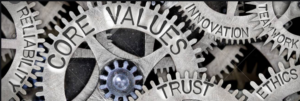
“My definition of success: When your core values and self-concept are in harmony with your daily actions and behaviors.”
—John Spence
I’m currently working with the leadership team of an organization that is investing time to revisit its core values and mission. At our first session, I drew upon the work of Collins and Poras (Built to Last) which identifies an organization’s core values as the guiding principles for behaviors and decisions which, over time, will serve to preserve its essence and foster endurance and success. I also shared the work of Patrick Lencioni (The Advantage) who identifies Core Values as those elements that define the personality, provide clarity, and guide every aspect of the organization. By the conclusion of the session the team had identified seven to eight inherent values they believed could serve as core values; or so they thought.
At the beginning of our second session I asked each member of the leadership team to identify their own core values. It was an interesting exercise. For some it came easy, others needed to wrestle with it. Why? Because like many others, this isn’t something that they have ever been formally asked to do. Think about it, when was the last time you really pondered your core values? Most of us simply take them for granted; our core values are what help us distinguish between right and wrong, good and evil, or success and failure. What it really comes down to is awareness. By being aware of our core values, we are provided with a guide that makes life more meaningful and helps us tremendously with our decisions. So how is this awareness created? It’s a Four Step Process:
-
Identify What is Important to You Right Now: Create a list of all that brings meaning and value to your life. Think of the things that make you happy, fulfilled, or bring about a sense of wellness. Likewise consider those things that have have brought you sadness, guilt, or failure and then identify the opposite. If you are having difficulty consider This Core Value List, but don’t simply use these words, rather let the list be the impetus that helps you identify a meaningful situation in your life.
-
Find the Trends or Patterns: When the list is complete, look for patterns or trends. What resurfaces? Perhaps it is your Family, Friendships, Relationships, Faith, Health, Meaningful Work, or Fun.
-
Rank the Values: Once the list is complete, rank the values based on how they speak to you. Which two or three are your “Go to” values that you consider when you must make those critical decisions. They serve to guide your behaviors and actions more than the others.
-
Create Awareness: Give your values meaning and create a sense of awareness by bringing them to life with a phrase. For example my three values are embodied in the following:
-
-
Honesty/Integrity: My word is my honor.
-
Faith: My faith is my compass.
-
Family: My family is my strength.
-
Our core values are what distinguish us from everyone else. They are not our only values, as we have values that guide our aspirations (creativity) and values that influence our relationships with others (empathy). But it is our core value that truly guide us, and in the end, influence us more than anything else.
In a few weeks I will be back in New York working with a leadership team I have come very much to admire, as they create a collective awareness of their corporate core values and then collaboratively re-create their organizational mission statement. As I think about what they are doing, I’m reminded of Simon Sinek’s words, “Most organizations can tell you what they do, some can tell you how they do it, but very few can tell you why.” How lucky am I to be working with a group of people who will not only understand their organizational “Why”, but have an awareness of both their corporate and personal core values? It doesn’t get much better than that!
